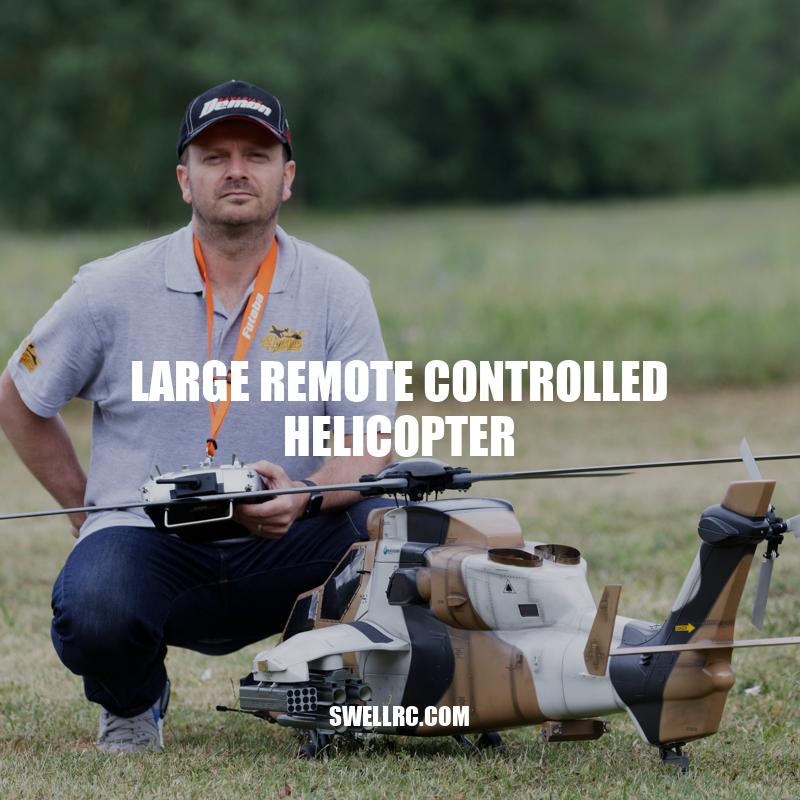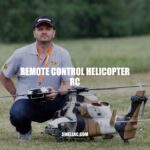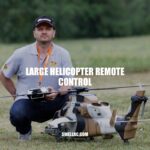Exploring Large Remote Controlled Helicopters: Design, Applications, and Maintenance
A large remote controlled helicopter is an impressive device that has captivated the imaginations of many hobbyists and professionals alike. These sophisticated aircraft provide a unique and exciting experience for pilots and offer an array of potential applications in various industries. While they may resemble their smaller counterparts, large remote controlled helicopters are a significant step up in terms of size, power, and capabilities.
One of the most exciting aspects of a large remote controlled helicopter is its design and features. In essence, the aircraft mimics the functionality of a conventional helicopter, utilizing a main rotor to generate lift and a tail rotor to provide stability. However, it also incorporates advanced features such as GPS, gyroscopes, and accelerometers to ensure that it remains stable during flight. The helicopter’s frame is typically constructed with lightweight materials like carbon fiber and aluminum, which maximizes the aircraft’s flight time and performance. Additionally, it can be configured with various cameras, sensors and even small payloads, thus making it suitable for a wide range of applications. These features contribute to making large remote controlled helicopters one of the most awe-inspiring machines that can be flown by amateurs and professionals alike.
Applications
A large remote controlled helicopter offers a wide range of potential applications across various industries, including:
- Aerial Photography and Videography: The ability to capture high-quality, panoramic footage from above enables filmmakers, photographers and surveyors to capture stunning images of landscapes and buildings that can’t be taken from the ground.
- Commercial and Industrial Inspections and Surveillance: Large remote controlled helicopters are used to conduct surveillance and monitor activities, inspect buildings, pipelines, storage tanks and industrial equipment. They also can be used to assess damage in emergency situations, including natural disasters and critical infrastructural accidents.
- Search and Rescue Operations: Large remote controlled helicopters equipped with thermal imaging cameras and other specialized equipment can be used to aid during search and rescue operations in natural disasters, building collapses, or other situations that limit access.
- Scientific Research: Researchers use large remote controlled helicopters to study the atmosphere, Marine life, and other natural ecosystems in remote areas that are difficult to access.
There are commercially available companies and online stores from where you can get your hands on a large remote controlled helicopter that may suit your application requirements. For instance, Horizon Hobby, DJI, and Aerial Media Pros are a few of the online stores where you can find an enormous collection of remote-controlled helicopters with excellent features and capabilities.
What is the largest remote control helicopter?
The largest remote control helicopter available on the market is the Blade Chroma Camera Drone. Here are some quick facts about this impressive helicopter:
- This drone is 24.8 inches long and has a rotor diameter of 18.9 inches
- It weighs just over three pounds
- Has a maximum flight time of 30 minutes when fully charged
- Designed with a 3-axis gimbal stabilization system for smooth camera footage
- Comes with a 4K camera attached to capture high-quality video footage and photos
If you’re looking for a top-of-the-line remote control helicopter, the Blade Chroma Camera Drone is it.
Design and Features
The design and features of large remote controlled helicopters vary depending on the model, but here are some prominent features to look for:
| Feature | Description |
|---|---|
| GPS Stabilization | A GPS system helps keep the helicopter stable in more adverse weather or external factors such as wind. |
| Flight Time | The average flight time for a large remote controlled helicopter is between 10 to 30 minutes, depending on the battery’s capacity. |
| Payload Capacity | The weight a helicopter can carry varies between models but ranges from 1kg to 5kg. |
| Camera Quality | The camera attached to the helicopter can have various specs, including 4K, full HD or even thermal imaging for industrial applications. |
Furthermore, some large remote controlled helicopters also come with:
- Live-streaming capabilities to display the helicopter’s camera footage in real-time on a monitor, tablet or smartphone.
- Foldable arms and props for easy transport and storage; which is an essential feature for users always on-the-go.
- Avoidance technology to prevent accidents, where rotor blades can automatically detect and avoid obstacles to reduce the risk of collisions or crashes.
The design and features of a large remote-controlled helicopter make it an enjoyable toy as well as a powerful tool to capture stunning visuals or operate in difficult or hazardous environments.
To browse and purchase some of the best large remote-controlled helicopters with the above features and more, click on this link to visit the DJI website.
What are the features of a helicopter?
Helicopters are unique and versatile aircraft. They have several features that set them apart from fixed-wing airplanes:
- Vertical take-off and landing capability
- Ability to hover in one spot
- Ability to fly forwards, backwards, and sideways
- Large windows for better visibility
- Rotating rotor blades for lift and propulsion
- Narrow body and compact size for maneuverability in tight spaces
- Ability to fly at low speeds and low altitudes
If you’re interested in learning more about helicopters, or even flying one yourself, there are many resources available online. Check out websites such as Private Pilot Training HQ for information on helicopter pilot training programs and requirements, or Vertical Magazine for news and stories about the helicopter industry.
Training and Licensing
Operating a large remote controlled helicopter requires skill and knowledge, so it’s crucial to go through proper training before taking to the skies. Some things to consider when it comes to training and licensing include:
- Learning from experienced pilots or joining a remote-controlled helicopter club that offers training sessions with an instructor.
- Obtaining a pilot’s license from a governing body or authorities that regulate UAVs (Unmanned Aerial Vehicles), such as the Federal Aviation Administration (FAA) in the United States.
- All UAV pilots are required to inform the FAA of their flights over a certain weight limit and area.
- The liability of the pilot regarding violation of airspace, damage to property or harm to individuals rests with the operator of the remote-controlled helicopter.
Reputable manufacturers and hobbyist clubs often provide additional educational resources to not only aid in purchasing the right helicopter but also to make sure the remote pilot obtains the right amount of experience to ensure compliance with local regulations.
How Hard Is It to Fly a Remote Control Helicopter?
Flying a remote control helicopter can be challenging, but with some practice, anyone can become proficient. Here are some things to keep in mind:
- Start with a beginner-friendly model that is easy to control.
- Practice in an open area with no obstacles.
- Understand the basics of how the controls work.
- Use slow and smooth movements to avoid crashing.
- Expect a learning curve, and don’t get discouraged!
If you need more help with flying a remote control helicopter, there are many online resources available, including tutorial videos and forums where you can ask for advice. Additionally, some products come with instructional guides or even virtual reality simulators to help you get started.
Maintenance and Repair
To ensure the reliability and longevity of a large remote-controlled helicopter, proper maintenance and repair are necessary. Here are some things to keep in mind:
- Always follow the manufacturer’s guidelines for maintenance tasks and frequency, including cleaning the outside and inside of the aircraft, as well as checking and replacing parts and components as needed.
- Regularly inspect the battery for signs of wear, bulges, or leaks, and replace if necessary, as it is the most common faltering component.
- Never operate a damaged or broken remote-controlled helicopter. Performing flight checks and performing non-flying assessments is essential to identify any abnormalities and prevent any accidents.
- Check for any issues, such as cracks or corrosion, that can impact the structural integrity of the helicopter. These defects will only continue to weaken the remote-controlled helicopter upon use.
Conclusion
Large remote-controlled helicopters are an exciting and versatile investment for anyone, whether you’re looking to have some fun or use them for research and practical purposes. They require proper training and a license to ensure the safety of those around the operator or the helicopter itself. And reliability depends on regular maintenance and timely repair to ensure a longevity of the remote-controlled helicopter. With due care of the operation and frequent maintenance, you can get the best experience and an extended use of your remote-controlled helicopter.



